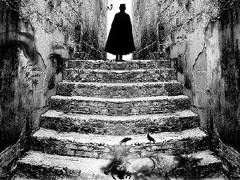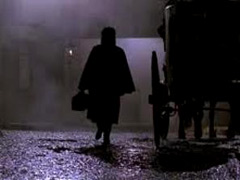


Over 140 men have been linked to the murders of five prostitutes in the Whitechapel area in 1888. The women’s bloodcurdling mutilations have been widely reported, as well as countless whodunit theories and possible motivations. What if it was the work of more than one man? What of the six other women, also murdered in Whitechapel, but stabbed rather than slashed? In over 100 hundred years no one has been able to find definite proof. Here are the most famous suspects...
Robert Mann, Morgue Attendant
In 2009 historian Mein Trow suggested the killer was Robert Mann, a morgue attendant who worked in the Whitechapel Mortuary. The murdered women were taken to this morgue, and Mann was called upon by the police to help establish the cause of death. There are reports that he undressed the body of Mary Ann Nicholls, the first victim, despite the police requesting that it not be touched. The Coroner recorded that Mann’s testimony was unreliable, however he was not regarded as a suspect at the time. Mann’s character fits the Jack the Ripper profile put together by the FBI: a male from a broken or deprived home, socially awkward towards other adults, and with enough knowledge of human anatomy to be able to remove their internal organs. Mann’s job at the mortuary also permitted him to spend long periods of time without any human contact, and he lived and worked near the killings. However not enough is known about him to conclusively prove his guilt.
\n\nCarl Feigenbaum, Sailor
Another recent theory claims that the Ripper wasn’t from Whitechapel at all, but was in fact a German sailor who alighted at the docks, and frequented prostitutes when in the area. Carl Feigenbaum was found guilty of killing a woman in New York in a similar style to the Ripper murders, six years after they’d taken place. Detective turned author Trevor Marriott believes he was aboard the Sylph, a cargo ship that arrived in London shortly before the death of the first victim, and departed two weeks after the murder of Mary Kelly, the last victim. Marriott also links Feigenbaum to six horrific murders in Managua, Nicaragua in January 1889. But then how would this sailor have acquired the surgical know-how to remove body organs so expertly from the bodies? Marriott points out that in only two cases were the body parts cut out with precision, and suggests this could have been carried out by traders in human body parts or by medical staff for training purposes. Feigenbaum was executed on the electric chair, but before his death he confessed to his lawyer, William Lawton, that he had homicidal tendencies toward women. Lawton later stated he believed his former client may have been responsible for the crimes.
Aaron Kosminski, Unemployed
A memo dating back to 1894 has Aaron Kosminski as a main suspect. Kosminski was a Polish Jew who lived in Whitechapel; he was mentally unstable, hated women, and there are disparate reports regarding his violent behaviour, some claim he was homicidal, others that he was totally harmless. The likelihood is that in the late 19th century some may have feared the behaviour of a man labelled insane. This may well have been the main reason he was considered a suspect. Other factors are the death of his father aged 22, which may have spurred him on to commit the crimes, and the blood-stained piece of apron belonging to victim Catherine Eddowes that police found on Goulston Street, where Kosminski lived with his siblings. Kosminski was interrogated and put under surveillance, and the FBI’s profile states that officers might have interviewed Jack the Ripper, which would have caused him to put a stop to the murders. Kosminski was committed in 1891, three years after the killings, however the links are too tenuous to put him firmly in the frame.
\n\nWalter Sickert, Artist
Crime novelist Patricia Cornwell incurred the wrath of art dealers in 2001 with her claims that British artist Walter Sickert was Jack the Ripper. Moreover, she ripped up a valuable canvas in an attempt to find DNA evidence linking him to the murders, but to no avail. One of the Mornington Crescent Group, Sickert painted scenes from everyday life, usually from photographs. His interest in the killing of a prostitute in Camden in 1908 prompted him to create a series of paintings called The Camden Town Murders. Cornwell stated that Sickert’s depictions of murdered women were strikingly similar to the victims; in one painting the woman’s pose is identical to that of Mary Kelly when she was found by the police. Her only other clue is a watermark found on Sickert’s stationery, which resembles that found on letters written by someone who had claimed to be the Ripper. What is certain is that her 2002 book Portrait of a Killer: Jack the Ripper – Case Closed sold a substantial amount of copies.
Royal Conspiracies
If you’ve seen the movie From Hell starring Johnny Depp, you’ll be familiar with the theory that Sir William Gull, doctor to Queen Victoria, may have been Jack the Ripper. In the film, he commits the crimes to protect the interests of the Royal Family, as Prince Albert Victor, the Queen’s grandson and potential heir to the throne, has fathered a child with a friend of the prostitutes, and he murders them to prevent the story leaking. It’s a similar hypothesis to that of Tony Williams, who believes his great-great-great-great uncle Sir John Williams, Queen Victoria’s surgeon, to be responsible. In this case the motive is a little hazier, as Williams believes he was tormented by the fact that his wife couldn’t have children, and this is what drove him to kill. He certainly had the surgical expertise to disembowel the victims – in fact three years before her death he performed an abortion on Mary Ann Nicholls. A further theory goes as far to suggest that it was Prince Albert himself who performed the murders, after contracting syphilis and going insane, however most historians have filed this one away with countless other sensationalist royal conspiracies.


